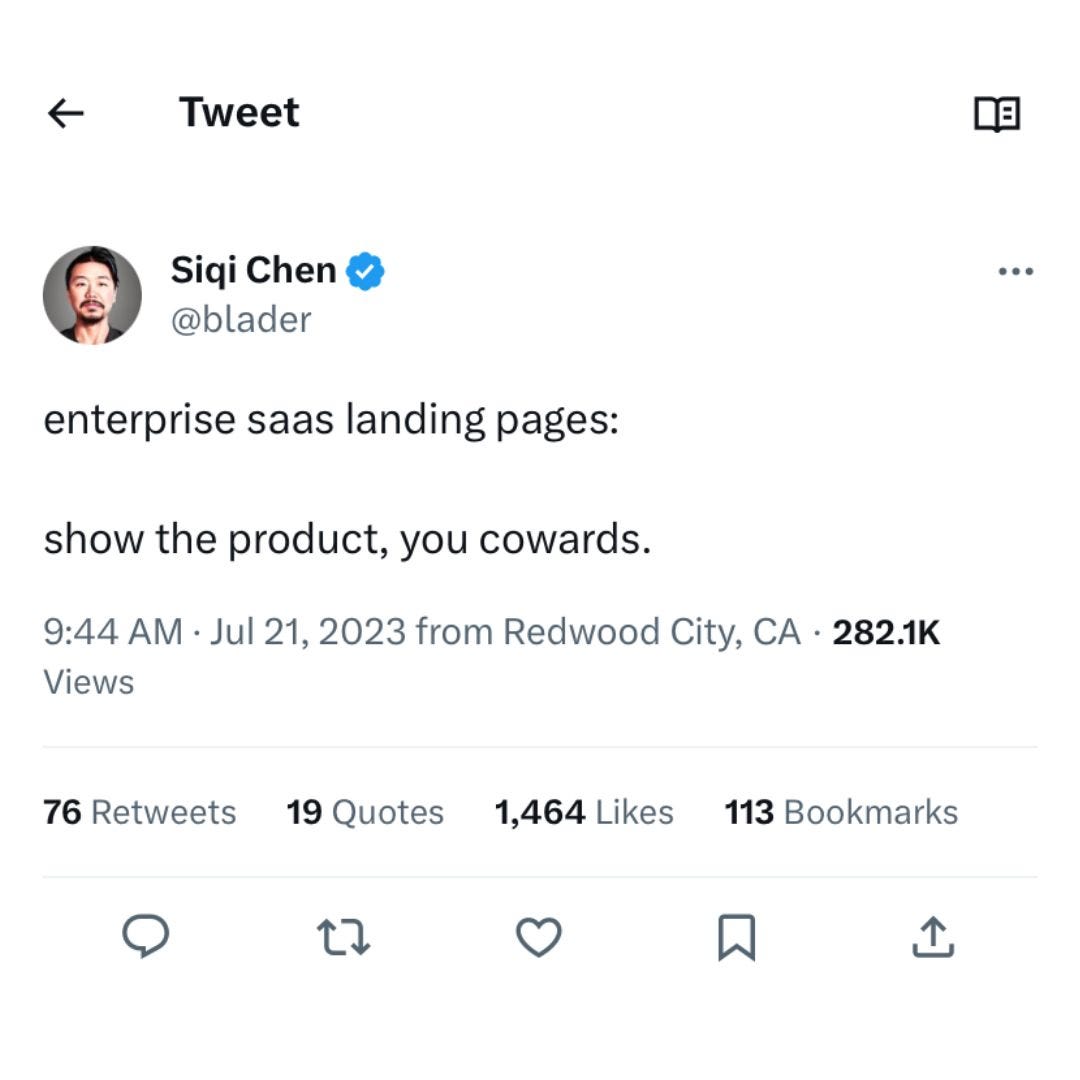What's trust got to do with it?
It's one of the biggest buying influencer in B2B SaaS. But what is it? And how do you even create it?
Research by Matthew Dixon (Book: The JOLT Effect) showed that 40-60% of failed B2B sales are due to customers’ fear of change and lack of trust, not because they didn’t see value in the product.
Meaning, even if people were excited about a product’s value, many buyers did not complete the purchase because they perceived too much risk.
Which can be confusing for some companies since so much marketing is focused on ‘promoting more value’.
But what does a lack of ‘trust’ even mean?
It means that buyers were not convinced that:
The product was going to do what it promised.
The effort of buying & adopting the product was worth the time and cost.
They weren’t going to look silly in front of their boss for championing the new product.
83% of consumers say they will not do business with brands they don’t trust (Gartner)
It’s important to note - B2B SaaS is not a product. It’s a change in a business process.
And as such, it comes with it’s own risks and hesitations.
Positioning, messaging and awareness is insanely important and necessary before the rest of the buyer journey is possible.
However, getting customers to understand your value is only the 1st part of the process.
The 2nd part is getting them to trust that your value is what you say it is.
E.g. If your product’s promise is "We help teachers save 3 hours a week in marking homework" - that’s Great! But the next question is:
How do you do that?
Can show me how to get that result?
Show me someone who's done it before?
What was this data based off?
Can everyone else expect these results?
Was this data taken from a very slow teacher?
I have my own unique way of operating - how do I know this will work for me too?
Traditionally this is where sales would step in and help reassure and guide customers through it.
However, with:
The younger digital-native generation rising the ranks,
More products having a high-class self-service option, and,
The number of products available to buyers increasing,
More buyers are waiting to the very last minute to speak with sales teams (or resisting them altogether).
Research by G2 in 2023 found that 68% of buyers only involve sales at the last stage of the buyer's journey.
Whilst the role of sales is still incredibly important for B2B growth, we need to find more ways to build trust - long before they’re willing to speak to us.
But how?
The gold & oldie method - social proof.
Social proof is still one of the most powerful levers for trust. It typically comes in the form of testimonies, case studies from successful customers, general 3rd party supporters, etc.
In other words - if everyone who looks like you, sounds like you and acts like you says this product is worth buying - then it should probably be safe to purchase, right?
Social proof is one of the most powerful influencers for human behaviours in general.
Human’s are instinctively desperate to assimilate and follow the crowd.
If everyone goes left, most won't even question why they are going left… They'll just follow.
Of course for startups this can be hard, since you may not yet have enough traction and data to show.
Nevertheless, testimonies and case studies should be obtained and shared as early and as often as possible!
Comparison and rating sites like Capterra and Sourceforge are also great ways to build social proof.
Transferred Trust - A.k.a. Referrals
An extension to social proof is where trust can be transferred. A.k.a. a 'referral'.
This is also insanely valuable and typically the one channel with the highest conversion rates.
When someone you know and trust recommends you purchase something they believe in - human’s tend to reflect that trust and (in turn) are more likely to trust you as well.
I've seen many occasions where a trusted referral has been enough to speed up the sales cycle, increase the price of the sale and provide a super strong-fit customer.
But again this relies on an established user base of happy customers. Which is why:
The best marketing strategy is a great product and happy customers
The best referrals are organic ones from satisfied customers, since that is the point of a referral… It should come from a non-bias 3rd party… So it’s… trusted.
92% of consumers trust referrals from friends and family over other forms of advertising. (source: exploding topics)
However it is possible to speed this up by exploring:
Referral programs (that include rewards/incentives to the referrer).
88% of Americans say they would like some sort of incentive for sharing products on social media (source: exploding topics).
Product-led growth loops that encourage users to share & invite their network early in the process (more on that here).
Or simply just asking… Only 29% of customers actually make referrals without being prompted to do so (source: exploding topics).
Let your product create the Trust
Sometimes letting the product speak for itself can be the fastest form of creating trust.
Product integrity - i.e. doing what you say you can do.
This is why free trials, freemium models and public clickthrough demos are so powerful.
Letting your market tangibly see the value of your product - without the friction of needing to book a demo.
Saying you have the best homework marking tool is important, but proving you have the best homework marketing tool is where the buy-in occurs.
Giving them a taste of what they can expect is a quick way to build trust.
There is a popular rise in B2B SaaS companies making clickthrough demos of their product publicly available.
The company HowdyGo is doing incredible work in this area. It is a handy tool that can create these interactive clickthroughs for websites, guides and more.
Content - Building your own trusted authority
Trust can also be built by showing you know your buyers, know their problems and know how to fix their problems.
This is where content and demand gen marketers can bring a lot of value.
Giving people advice, solutions, guides and insights on how to solve their pains and problems.
Establishing you’re the best place to go to fix their worries.
Doing this properly requires a legitimate and intimate understanding of who your buyers are, the jobs they do and the challenges the face.
As early as possible. It means we need to create content that:
Helps your buyers understand how the problem you solve effects their business. The better they understand the cause of the issue, the better equipped they are to solve it.
Helps build trust and confidence by showing them your expertise in solving these problems. Giving them advice and tools solve their problem, without having to buy your product.
We need to be far more influential by the time they are ready to purchase (more on that here).
Lastly - trust through familiarity
Lastly, trust can also be built via familiarity (although shouldn't be solely relied upon).
Just like when you meet a friend-of-a-friend a half dozen times at events, you begin to develop familiarity with that person and might be more open to chatting with them than you were earlier.
Humans fear the unknown. And as such we reject it. Even if it looks and sounds great.
So taking the time to build your brand and show up in your buyers life consistently and positively can be an indirect way to build trust.
In the 1960’s, psychologist Robert Zajonc found that the more people are exposed to certain stimuli, the more they demonstrate a positive preference for those stimuli and take them as truth.
A phenomenon is known as the Mere Exposure Effect. In other words, we tend to gravitate toward, and trust, things we are familiar with.
Thankfully for businesses today - we have social media.
A direct channel to a large number of buyer eyeballs.
For B2B marketing, organic LinkedIn posting is now one of the most powerful channels.
Especially in Australia where is it transitioning in popularity from a once spammy jobs network, to a quality source of short and long from B2B content.
The methods above can indirectly create familiarity - so the more of them you do, the more familiar you’ll be.
The Cost of Losing Trust
During the buyer journey, a single misstep can erode trust rapidly, leaving your prospects skeptical of every claim you make going forward.
Some common ways of losing trust are:
Over-promising and under-delivering
Lack of transparency
Complicated onboarding or high perceived effort
Inconsistent messaging
Poor customer support
Failure to deliver on social proof
Pushing too hard for a sale
Inconsistent product experience
Ignoring feedback or failing to address concerns
Misalignment between sales and product reality
Data security and privacy concerns
Building trust in the B2B SaaS is just as crucial (if not more so now) than demonstrating the value of your product.
Fear of change and lack of trust account for a significant portion of lost sales.
It’s no longer enough to simply show your product’s value - you must also prove that it will deliver on its promises with minimal risk to the buyer.
B2B companies that prioritise trust, align their messaging and maintain transparency at every touchpoint are more likely to generate more quality leads and (subsequently) close more sales.
If aren’t sure how to create more trust throughout your customer journey - feel free to click here to reach out for a chat!






